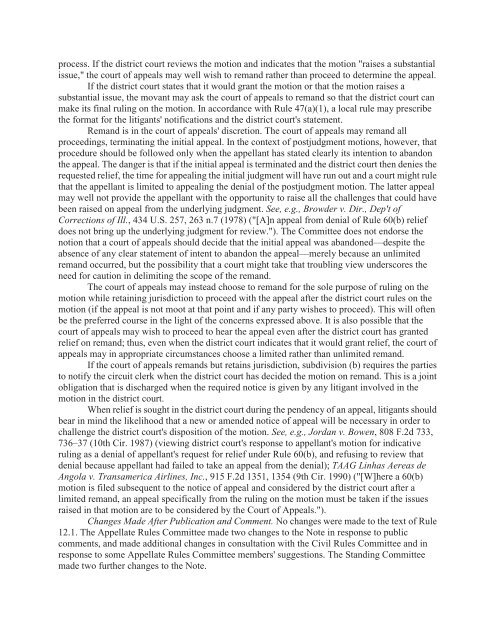Federal Rules of Appellate Procedure 2014-2015, 2014a
Federal Rules of Appellate Procedure 2014-2015, 2014a
Federal Rules of Appellate Procedure 2014-2015, 2014a
Create successful ePaper yourself
Turn your PDF publications into a flip-book with our unique Google optimized e-Paper software.
process. If the district court reviews the motion and indicates that the motion "raises a substantial<br />
issue," the court <strong>of</strong> appeals may well wish to remand rather than proceed to determine the appeal.<br />
If the district court states that it would grant the motion or that the motion raises a<br />
substantial issue, the movant may ask the court <strong>of</strong> appeals to remand so that the district court can<br />
make its final ruling on the motion. In accordance with Rule 47(a)(1), a local rule may prescribe<br />
the format for the litigants' notifications and the district court's statement.<br />
Remand is in the court <strong>of</strong> appeals' discretion. The court <strong>of</strong> appeals may remand all<br />
proceedings, terminating the initial appeal. In the context <strong>of</strong> postjudgment motions, however, that<br />
procedure should be followed only when the appellant has stated clearly its intention to abandon<br />
the appeal. The danger is that if the initial appeal is terminated and the district court then denies the<br />
requested relief, the time for appealing the initial judgment will have run out and a court might rule<br />
that the appellant is limited to appealing the denial <strong>of</strong> the postjudgment motion. The latter appeal<br />
may well not provide the appellant with the opportunity to raise all the challenges that could have<br />
been raised on appeal from the underlying judgment. See, e.g., Browder v. Dir., Dep't <strong>of</strong><br />
Corrections <strong>of</strong> Ill., 434 U.S. 257, 263 n.7 (1978) ("[A]n appeal from denial <strong>of</strong> Rule 60(b) relief<br />
does not bring up the underlying judgment for review."). The Committee does not endorse the<br />
notion that a court <strong>of</strong> appeals should decide that the initial appeal was abandoned—despite the<br />
absence <strong>of</strong> any clear statement <strong>of</strong> intent to abandon the appeal—merely because an unlimited<br />
remand occurred, but the possibility that a court might take that troubling view underscores the<br />
need for caution in delimiting the scope <strong>of</strong> the remand.<br />
The court <strong>of</strong> appeals may instead choose to remand for the sole purpose <strong>of</strong> ruling on the<br />
motion while retaining jurisdiction to proceed with the appeal after the district court rules on the<br />
motion (if the appeal is not moot at that point and if any party wishes to proceed). This will <strong>of</strong>ten<br />
be the preferred course in the light <strong>of</strong> the concerns expressed above. It is also possible that the<br />
court <strong>of</strong> appeals may wish to proceed to hear the appeal even after the district court has granted<br />
relief on remand; thus, even when the district court indicates that it would grant relief, the court <strong>of</strong><br />
appeals may in appropriate circumstances choose a limited rather than unlimited remand.<br />
If the court <strong>of</strong> appeals remands but retains jurisdiction, subdivision (b) requires the parties<br />
to notify the circuit clerk when the district court has decided the motion on remand. This is a joint<br />
obligation that is discharged when the required notice is given by any litigant involved in the<br />
motion in the district court.<br />
When relief is sought in the district court during the pendency <strong>of</strong> an appeal, litigants should<br />
bear in mind the likelihood that a new or amended notice <strong>of</strong> appeal will be necessary in order to<br />
challenge the district court's disposition <strong>of</strong> the motion. See, e.g., Jordan v. Bowen, 808 F.2d 733,<br />
736–37 (10th Cir. 1987) (viewing district court's response to appellant's motion for indicative<br />
ruling as a denial <strong>of</strong> appellant's request for relief under Rule 60(b), and refusing to review that<br />
denial because appellant had failed to take an appeal from the denial); TAAG Linhas Aereas de<br />
Angola v. Transamerica Airlines, Inc., 915 F.2d 1351, 1354 (9th Cir. 1990) ("[W]here a 60(b)<br />
motion is filed subsequent to the notice <strong>of</strong> appeal and considered by the district court after a<br />
limited remand, an appeal specifically from the ruling on the motion must be taken if the issues<br />
raised in that motion are to be considered by the Court <strong>of</strong> Appeals.").<br />
Changes Made After Publication and Comment. No changes were made to the text <strong>of</strong> Rule<br />
12.1. The <strong>Appellate</strong> <strong>Rules</strong> Committee made two changes to the Note in response to public<br />
comments, and made additional changes in consultation with the Civil <strong>Rules</strong> Committee and in<br />
response to some <strong>Appellate</strong> <strong>Rules</strong> Committee members' suggestions. The Standing Committee<br />
made two further changes to the Note.


















